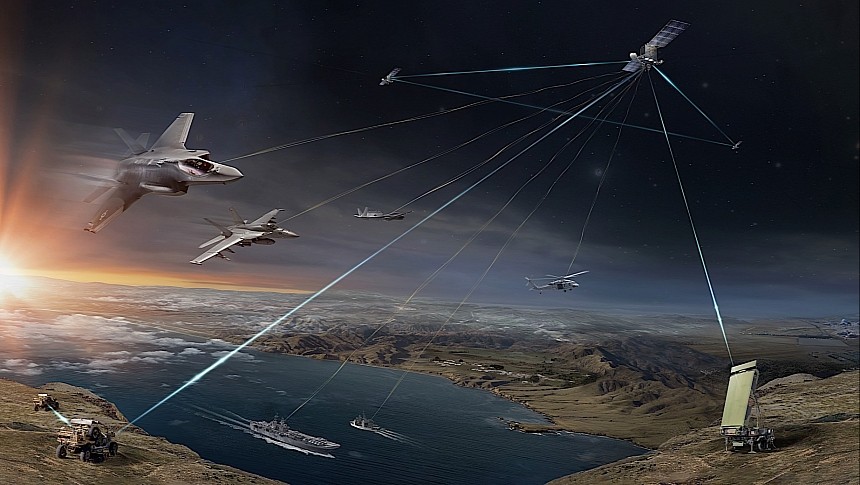With all the significant advances in military technology made in recent years, the weapons and strategies of the American military can be literally considered off the charts. But there is one major problem with all these advanced technologies: they are not used to the fullest of their capabilities.
I mean, imagine how potent the military punch of the United States would be if sensors, comms systems, weapons platforms, and the weapons themselves were connected into a single digital ecosystem spanning across military branches. Not only connected to each other, but with the systems of allied forces as well.
That's what the U.S. is trying to do through a program called Joint All-Domain Command and Control (JADC2). The concept was first tested in December 2019, and has evolved greatly since, with some of the tech developed for it already in use.
This week we got word of another major advancement in JADC2 development. Defense contractor Northrop Grumman put to the test the "latest mobile ground station technology for the frontline," a system meant no more no less to provide any and all data, at any time, for any mission of the U.S. Navy and the Marine Corps.
The ground station is called Maritime Targeting Cell - Expeditionary (MTC-X) and it was designed specifically for use in missions that require great mobility. The system is an upgrade of the MTC-A (Maritime Targeting Cell - Afloat), a piece of tech that gathers information gathered by sensors and sends it to communication nodes based on land and at sea, even in denied environments.
The prototype made by Northrop Grumman is designed to do the same thing, but it will be able to send its data to forward-deployed units and individual soldiers located far from their bases.
Because it will integrate data from multiple sources into a single system, MTC-X will help reduce sensor-to-shooter time and more accurately direct long-range fire.
Although we're not given actual details on what this means, we're told MTC-X, as per its designation, can be easily and quite rapidly moved and assembled to serve the needs of fighting forces.
Neither of the parties involved says when the system will be ready for deployment on the world's battlefields, but given how it is a component of the U.S. Marine Corps Force Design 2030 plan, the end of the decade seems about right.
The plan was announced by the Marine Corps in late 2021, and it is, in essence, a restructuring effort with the important aim of modernizing equipment and getting new and advanced pieces of hardware.
As for the JADC2 concept, it already includes several advanced technologies, headlined by Starlink satellites. Disposable cargo drones, fighter jets, and the upcoming LMXT aerial tanker will be part of this military ecosystem as well.
That's what the U.S. is trying to do through a program called Joint All-Domain Command and Control (JADC2). The concept was first tested in December 2019, and has evolved greatly since, with some of the tech developed for it already in use.
This week we got word of another major advancement in JADC2 development. Defense contractor Northrop Grumman put to the test the "latest mobile ground station technology for the frontline," a system meant no more no less to provide any and all data, at any time, for any mission of the U.S. Navy and the Marine Corps.
The ground station is called Maritime Targeting Cell - Expeditionary (MTC-X) and it was designed specifically for use in missions that require great mobility. The system is an upgrade of the MTC-A (Maritime Targeting Cell - Afloat), a piece of tech that gathers information gathered by sensors and sends it to communication nodes based on land and at sea, even in denied environments.
The prototype made by Northrop Grumman is designed to do the same thing, but it will be able to send its data to forward-deployed units and individual soldiers located far from their bases.
Because it will integrate data from multiple sources into a single system, MTC-X will help reduce sensor-to-shooter time and more accurately direct long-range fire.
Although we're not given actual details on what this means, we're told MTC-X, as per its designation, can be easily and quite rapidly moved and assembled to serve the needs of fighting forces.
Neither of the parties involved says when the system will be ready for deployment on the world's battlefields, but given how it is a component of the U.S. Marine Corps Force Design 2030 plan, the end of the decade seems about right.
The plan was announced by the Marine Corps in late 2021, and it is, in essence, a restructuring effort with the important aim of modernizing equipment and getting new and advanced pieces of hardware.
As for the JADC2 concept, it already includes several advanced technologies, headlined by Starlink satellites. Disposable cargo drones, fighter jets, and the upcoming LMXT aerial tanker will be part of this military ecosystem as well.






